-
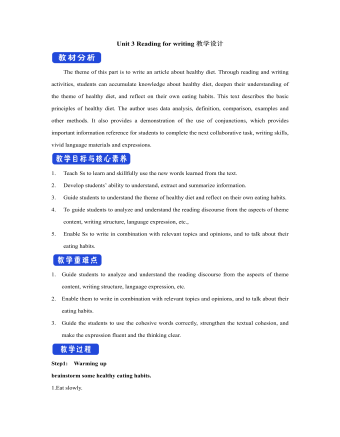
新人教版高中英语选修2Unit 3 Reading for writing教学设计
The theme of this part is to write an article about healthy diet. Through reading and writing activities, students can accumulate knowledge about healthy diet, deepen their understanding of the theme of healthy diet, and reflect on their own eating habits. This text describes the basic principles of healthy diet. The author uses data analysis, definition, comparison, examples and other methods. It also provides a demonstration of the use of conjunctions, which provides important information reference for students to complete the next collaborative task, writing skills, vivid language materials and expressions.1. Teach Ss to learn and skillfully use the new words learned from the text.2. Develop students’ ability to understand, extract and summarize information.3. Guide students to understand the theme of healthy diet and reflect on their own eating habits.4. To guide students to analyze and understand the reading discourse from the aspects of theme content, writing structure, language expression, etc., 5. Enable Ss to write in combination with relevant topics and opinions, and to talk about their eating habits.1. Guide students to analyze and understand the reading discourse from the aspects of theme content, writing structure, language expression, etc.2. Enable them to write in combination with relevant topics and opinions, and to talk about their eating habits.3. Guide the students to use the cohesive words correctly, strengthen the textual cohesion, and make the expression fluent and the thinking clear.Step1: Warming upbrainstorm some healthy eating habits.1.Eat slowly.2.Don’t eat too much fat or sugar.3.Eat healthy food.4.Have a balanced diet.Step2: Read the passage and then sum up the main idea of each paragraph.

新人教版高中英语选修2Unit 4 Learning about Language教学设计
This section guides students to pay attention to the typical context of vocabulary use, helps students accumulate vocabulary around the key vocabulary of this unit, and uses the learned words and word chunks in different contexts to deeply understand their meaning and usage, so as to achieve the purpose of review and consolidation.The teaching design activities aim to guide students to pay attention to the typical context in which the target vocabulary is used, as well as the common vocabulary used in collocation, so that students can complete the sentence with correct words. In terms of vocabulary learning strategies, this unit focuses on cultivating students' ability to pay attention to collocation of words and to use word blocks to express meaning.For vocabulary learning, it is not enough just to know the meaning of a single word, but the most important thing is to master the common collocations of words, namely word blocks.Teachers should timely guide students to summarize common vocabulary collocation, such as verb and noun collocation, verb and preposition collocation, preposition and noun collocation, and so on.1. Guide students to understand and consolidate the meaning and usage of the vocabulary in the context, 2. Guide the students to use the unit topic vocabulary in a richer context3. Let the students sort out and accumulate the accumulated vocabulary, establishes the semantic connection between the vocabulary,4. Enable students to understand and master the vocabulary more effectivelyGuiding the Ss to use unit topic words and the sentence patterns in a richer context.

新人教版高中英语选修2Unit 4 Using langauge-Listening教学设计
The theme of the listening section is " talking about scenery and culture along a journey."The part is designed to further lead the students to understand Canadian natural geography and social environment, and integrated into the cultural contrast by mentioning the long train journey from Beijing to Moscow routes. On this basis, the part activates students related travel experience, lets the student serial dialogue, guides the student to explore further the pleasure and meaning of the long journey, and Chinese and foreign cultural comparison.The part also provides a framework for the continuation of the dialogue, which is designed to provide a framework for students to successfully complete their oral expressions, and to incorporate an important trading strategy to end the dialogue naturally.1. Help students to understand and master some common English idioms in the context, and experience the expression effect of English idioms.2. Guide the students to understand the identity of different people in the listening context, and finish the dialogue according to their own experience.3. Instruct the students to use appropriate language to express surprise and curiosity about space and place in the dialogue, and master the oral strategy of ending the dialogue naturally.1. Instruct students to grasp the key information and important details of the dialogue.2. Instruct students to conduct a similar talk on the relevant topic.

新人教版高中英语选修2Unit 5 Learning about Language教学设计
The purpose of this section of vocabulary exercises is to consolidate the key words in the first part of the reading text, let the students write the words according to the English definition, and focus on the detection of the meaning and spelling of the new words. The teaching design includes use English definition to explain words, which is conducive to improving students' interest in vocabulary learning, cultivating their sense of English language and thinking in English, and making students willing to use this method to better grasp the meaning of words, expand their vocabulary, and improve their ability of vocabulary application. Besides, the design offers more context including sentences and short passage for students to practice words flexibly.1. Guide students to understand and consolidate the meaning and usage of the vocabulary in the context, 2. Guide the students to use the unit topic vocabulary in a richer context3. Let the students sort out and accumulate the accumulated vocabulary, establishes the semantic connection between the vocabulary,4. Enable students to understand and master the vocabulary more effectivelyGuiding the Ss to use unit topic words and the sentence patterns in a richer context.Step1: Read the passage about chemical burns and fill in the blanks with the correct forms of the words in the box.

新人教版高中英语选修2Unit 5 Reading and thinking教学设计
The theme of this activity is to learn the first aid knowledge of burns. Burns is common in life, but there are some misunderstandings in manual treatment. This activity provides students with correct first aid methods, so as not to take them for granted in an emergency. This section guides students to analyze the causes of scald and help students avoid such things. From the perspective of text structure and collaborative features, the text is expository. Expository, with explanation as the main way of expression, transmits knowledge and information to readers by analyzing concepts and elaborating examples. This text arranges the information in logical order, clearly presents three parts of the content through the subtitle, accurately describes the causes, types, characteristics and first aid measures of burns, and some paragraphs use topic sentences to summarize the main idea, and the level is very clear.1. Guide students to understand the causes, types, characteristics and first aid methods of burns, through reading2. Enhance students’ ability to deal withburnss and their awareness of burns prevention3. Enable students to improve the ability to judge the types of texts accurately and to master the characteristics and writing techniques of expository texts.Guide students to understand the causes, types, characteristics and first aid methods of burns, through readingStep1: Lead in by discussing the related topic:1. What first-aid techniques do you know of ?CPR; mouth to mouth artificial respiration; the Heimlich Manoeuvre

新人教版高中英语选修2Unit 5 Using langauge-Listening教学设计
The theme of this section is to learn how to make emergency calls. Students should learn how to make emergency calls not only in China, but also in foreign countries in English, so that they can be prepared for future situations outside the home.The emergency telephone number is a vital hotline, which should be the most clear, rapid and effective communication with the acute operator.This section helps students to understand the emergency calls in some countries and the precautions for making emergency calls. Through the study of this section, students can accumulate common expressions and sentence patterns in this context. 1.Help students accumulate emergency telephone numbers in different countries and learn more about first aid2.Guide the students to understand the contents and instructions of the telephone, grasp the characteristics of the emergency telephone and the requirements of the emergency telephone.3.Guide students to understand the first aid instructions of the operators.4.Enable Ss to make simulated emergency calls with their partners in the language they have learned1. Instruct students to grasp the key information and important details of the dialogue.2. Instruct students to conduct a similar talk on the relevant topic.Step1:Look and discuss:Match the pictures below to the medical emergencies, and then discuss the questions in groups.
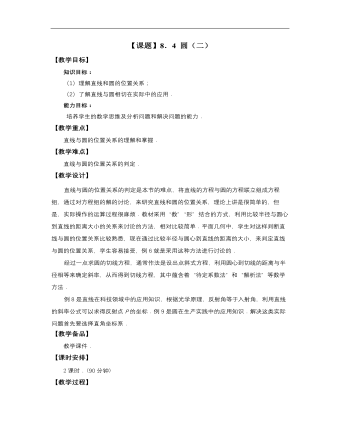
高教版中职数学基础模块下册:8.4《圆》教学设计
教 学 过 程教师 行为学生 行为教学 意图时间 *揭示课题 8.4 圆(二) *创设情境 兴趣导入 【知识回顾】 我们知道,平面内直线与圆的位置关系有三种(如图8-21): (1)相离:无交点; (2)相切:仅有一个交点; (3)相交:有两个交点. 并且知道,直线与圆的位置关系,可以由圆心到直线的距离d与半径r的关系来判别(如图8-22): (1):直线与圆相离; (2):直线与圆相切; (3):直线与圆相交. 介绍 讲解 说明 质疑 引导 分析 了解 思考 思考 带领 学生 分析 启发 学生思考 0 15*动脑思考 探索新知 【新知识】 设圆的标准方程为 , 则圆心C(a,b)到直线的距离为 . 比较d与r的大小,就可以判断直线与圆的位置关系. 讲解 说明 引领 分析 思考 理解 带领 学生 分析 30*巩固知识 典型例题 【知识巩固】 例6 判断下列各直线与圆的位置关系: ⑴直线, 圆; ⑵直线,圆. 解 ⑴ 由方程知,圆C的半径,圆心为. 圆心C到直线的距离为 , 由于,故直线与圆相交. ⑵ 将方程化成圆的标准方程,得 . 因此,圆心为,半径.圆心C到直线的距离为 , 即由于,所以直线与圆相交. 【想一想】 你是否可以找到判断直线与圆的位置关系的其他方法? *例7 过点作圆的切线,试求切线方程. 分析 求切线方程的关键是求出切线的斜率.可以利用原点到切线的距离等于半径的条件来确定. 解 设所求切线的斜率为,则切线方程为 , 即 . 圆的标准方程为 , 所以圆心,半径. 图8-23 圆心到切线的距离为 , 由于圆心到切线的距离与半径相等,所以 , 解得 . 故所求切线方程(如图8-23)为 , 即 或. 说明 例题7中所使用的方法是待定系数法,在利用代数方法研究几何问题中有着广泛的应用. 【想一想】 能否利用“切线垂直于过切点的半径”的几何性质求出切线方程? 说明 强调 引领 讲解 说明 引领 讲解 说明 观察 思考 主动 求解 思考 主动 求解 通过例题进一步领会 注意 观察 学生 是否 理解 知识 点 50
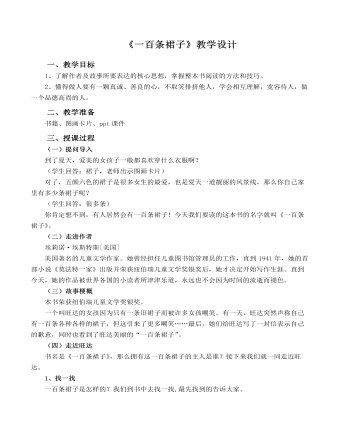
《一百条裙子》阅读课导读教案教学设计
1、书中还有许多描写旺达的片段,哪一处给你留下了深刻的印象呢?请同座位互相交流。全班交流。老师也想和大家一起分享一点感受。老师读第13页片段,并谈感受。课件出示:孤单,被嘲笑者2、你有过被人嘲笑的经历吗?谈一谈。旺达是怎样面对同学们的嘲笑?3、转学之后,十三班的同学们收到了她爸爸的来信。谁愿意读读这封信?圣诞节来临之际,旺达也写来一封信。学生读。读完这两封信,大家肯定感慨万千,一定有很多话想说吧?全班交流课件出示:善良 宽容
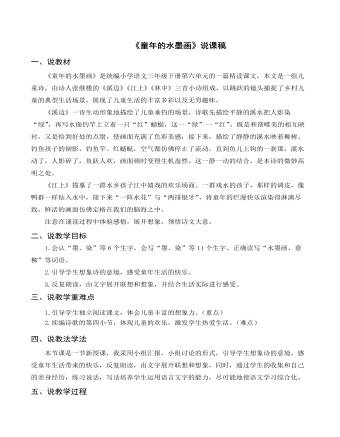
(说课稿)部编人教版三年级下册《童年的水墨画》
一、说教材《童年的水墨画》是统编小学语文三年级下册第六单元的一篇精读课文,本文是一组儿童诗,由诗人张继楼的《溪边》《江上》《林中》三首小诗组成,以跳跃的镜头捕捉了乡村儿童的典型生活场景,展现了儿童生活的丰富多彩以及无穷趣味。 《溪边》一诗生动形象地描绘了儿童垂钓的场景。诗歌先描绘平静的溪水把人影染“绿”,再写水面钓竿上立着一只“红”蜻蜓,这一“绿”一“红”,既是和谐唯美的相互映衬,又是恰到好处的点缀,使画面充满了色彩美感;接下来,描绘了静静的溪水映着柳树、钓鱼孩子的倒影、钓鱼竿、红蜻蜓,空气都仿佛停止了流动,直到鱼儿上钩的一刹那,溪水动了,人影碎了,鱼跃人欢,画面顿时变得生机盎然。这一静一动的结合,是本诗的微妙高明之处。 《江上》描摹了一群水乡孩子江中嬉戏的欢乐场面。一群戏水的孩子,那样的调皮,像鸭群一样钻入水中,接下来“一阵水花”与“两排银牙”,将童年的烂漫快乐渲染得淋漓尽致,鲜活的画面仿佛定格在我们的脑海之中。

(说课稿)部编人教版三年级下册《 昆虫备忘录》
一、说教材《昆虫备忘录》是统编小学语文三年级下册第一单元中的略读课文,文章抓住了蜻蜓、瓢虫、独角仙、蚂蚱的特点进行介绍,教给了人们知识,表达了对生灵的喜爱之情。本节课通过引领学生学习备忘录,让学生了解备忘录的书写及作用,并学会书写备忘录。利用备忘录来记录自己感兴趣的内容。二、说学情只有了解读者的阅读现状,才能充分发挥文本的魅力。经过了两年多的学习,学生已经积累了一些识字的经验,学习重点逐渐向阅读过渡,也掌握了一些阅读方法,如:朗读、默读;借助图画、生活实际,联系上下文理解词语等。但是孩子们对于事物的观察还远远不够,对于昆虫的了解更是少之又少,体会昆虫的可爱,是一个难题。三、说教学目标1.熟知字词句,有感情朗读课文,积累优美语句。2.学习作者观察描写事物的能力。3.感受这四种昆虫的特点,培养热爱生灵的思想感情。
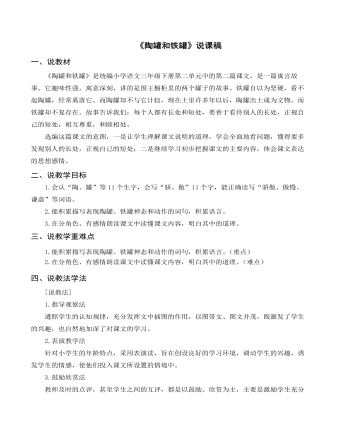
(说课稿)部编人教版三年级下册《 陶罐和铁罐》
四、说教法学法[说教法]1.指导观察法遵照学生的认知规律,充分发挥文中插图的作用,以图带文、图文并茂,既激发了学生的兴趣,也自然地加深了对课文的学习。 2.表演教学法 针对小学生的年龄特点,采用表演读,旨在创设良好的学习环境,调动学生的兴趣,诱发学生的情感,使他们投入课文所设置的情境中。 3.鼓励欣赏法 教师及时的点评,甚至学生之间的互评,都是以鼓励、欣赏为主,主要是激励学生充分地展示才能,满足他们希望得到赞许,体会成功的心理特点,激起学生学习的欲望,增强朗读的信心。[说学法]1.合作学习法在学生自读自悟的基础上,注重讨论、交流、合作、体会。让学生抓住课文主要内容的同时,能联想自己已有的知识积累。 2.美读训练法 以“看”“听”“说”“读”“悟”为主要训练方式,把“读”的训练贯穿在整个教学中,通过师与生、生与生面对面地提高、思考、讨论、交流、体会、练读逐步实现教学目标,让学生在具体的阅读实践中得到锻炼。
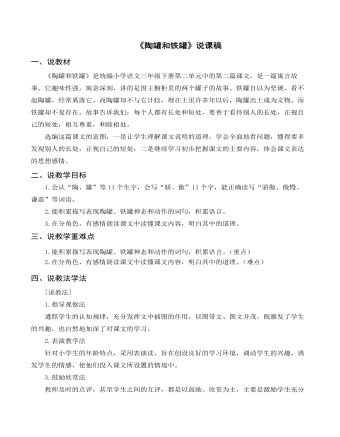
(说课稿)部编人教版三年级下册《 剃头大师》
三、说教学重难点1.能积累描写表现陶罐、铁罐神态和动作的词句,积累语言。(重点)2.在分角色、有感情朗读课文中读懂课文内容,明白其中的道理。(难点)四、说教法学法[说教法]1.指导观察法遵照学生的认知规律,充分发挥文中插图的作用,以图带文、图文并茂,既激发了学生的兴趣,也自然地加深了对课文的学习。 2.表演教学法 针对小学生的年龄特点,采用表演读,旨在创设良好的学习环境,调动学生的兴趣,诱发学生的情感,使他们投入课文所设置的情境中。 3.鼓励欣赏法 教师及时的点评,甚至学生之间的互评,都是以鼓励、欣赏为主,主要是激励学生充分地展示才能,满足他们希望得到赞许,体会成功的心理特点,激起学生学习的欲望,增强朗读的信心。
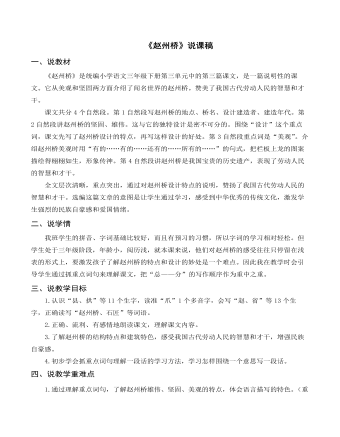
(说课稿)部编人教版三年级下册《 赵州桥》
一、说教材《赵州桥》是统编小学语文三年级下册第三单元中的第三篇课文,是一篇说明性的课文。它从美观和坚固两方面介绍了闻名世界的赵州桥。赞美了我国古代劳动人民的智慧和才干。 课文共分4个自然段。第1自然段写赵州桥的地点、桥名、设计建造者、建造年代。第2自然段讲赵州桥的坚固、雄伟。这与它的独特设计是密不可分的。围绕“设计”这个重点词,课文先写了赵州桥设计的特点,再写这样设计的好处。第3自然段重点词是“美观”。介绍赵州桥美观时用“有的……有的……还有的……所有的……”的句式,把栏板上龙的图案描绘得栩栩如生,形象传神。第4自然段讲赵州桥是我国宝贵的历史遗产,表现了劳动人民的智慧和才干。全文层次清晰,重点突出,通过对赵州桥设计特点的说明,赞扬了我国古代劳动人民的智慧和才干。选编这篇文章的意图是让学生通过学习,感受到中华优秀的传统文化,激发学生强烈的民族自豪感和爱国情绪。
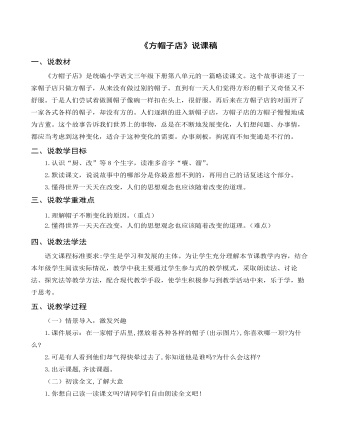
(说课稿)部编人教版三年级下册《方帽子店》
一、说教材《方帽子店》是统编小学语文三年级下册第八单元的一篇略读课文。这个故事讲述了一家帽子店只做方帽子,从来没有做过别的帽子。直到有一天人们觉得方形的帽子又奇怪又不舒服。于是人们尝试着做圆帽子像碗一样扣在头上,很舒服。再后来在方帽子店的对面开了一家各式各样的帽子,却没有方的。人们逐渐的进入新帽子店,方帽子店的方帽子慢慢地成为古董。这个故事告诉我们世界上的事物,总是在不断地发展变化,人们想问题、办事情,都应当考虑到这种变化,适合于这种变化的需要。办事刻板,拘泥而不知变通是不行的。二、说教学目标 1.认识“厨、改”等8个生字,读准多音字“嚷、溜”。 2.默读课文,说说故事中的哪部分是你最意想不到的,再用自己的话复述这个部分。 3.懂得世界一天天在改变,人们的思想观念也应该随着改变的道理。
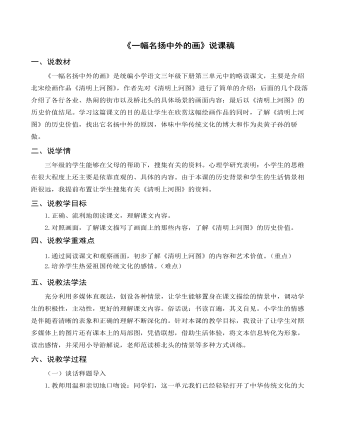
(说课稿)部编人教版三年级下册《一幅名扬中外的画》
一、说教材《一幅名扬中外的画》是统编小学语文三年级下册第三单元中的略读课文,主要是介绍北宋绘画作品《清明上河图》,作者先对《清明上河图》进行了简单的介绍;后面的几个段落介绍了各行各业、热闹的街市以及桥北头的具体场景的画面内容;最后以《清明上河图》的历史价值结尾。学习这篇课文的目的是让学生在欣赏这幅绘画作品的同时,了解《清明上河图》的历史价值,找出它名扬中外的原因,体味中华传统文化的博大和作为炎黄子孙的骄傲。二、说学情三年级的学生能够在父母的帮助下,搜集有关的资料。心理学研究表明:小学生的思维在很大程度上还主要是依靠直观的、具体的内容。由于本课的历史背景和学生的生活情景相距很远,我提前布置让学生搜集有关《清明上河图》的资料。三、说教学目标1.正确、流利地朗读课文,理解课文内容。2.对照画面,了解课文描写了画面上的那些内容,了解《清明上河图》的历史价值。四、说教学重难点1.通过阅读课文和观察画面,初步了解《清明上河图》的内容和艺术价值。(重点)2.培养学生热爱祖国传统文化的感情。(难点)

部编人教版三年级下册《习作七 国宝大熊猫》说课稿
一、说教材本单元习作的话题是"国宝熊猫",引导学生根据问题查找信息并尝试学习整合有关信息。熊猫教材编排了三个部分内容,第一部分教材首先提供了关于大熊猫许多小朋友都想了解的三个问题,使得本次习作具有更强的针对性,教材呈现的三个问题,有的指向熊猫的,有的指向熊猫的生活的地方,而熊猫为什么被视为"中国的国宝",则指向熊猫的价值,他们只是问题罗列,是小朋友可能提出问题的一部分,其作用是让学生从这些问题受到启发,打开思路继续提出自己有兴趣的问题,第二部分首先明确了本次习作的任务就是围绕这个话题介绍一下熊猫,为介绍大熊猫奠定了基础。二、说教学目标1、针对教材提出的问题,搜集国宝大熊猫的相关资料信息。2、初步学习整合信息,从不同方面介绍国宝大熊猫。3、走进国宝大熊猫,学习整合信息,从不同方面了解大能猫。三、说教学重难点教学重点∶初步学习整合大熊猫的信息,结合资料,从自己感兴趣的方面介绍国宝大熊猫。教学难点∶利用搜集的信息,按一定的顺序准确地介绍大熊猫。
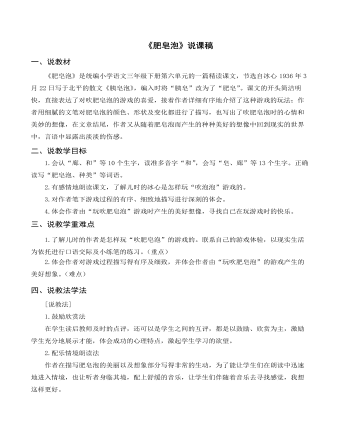
(说课稿)部编人教版三年级下册《 肥皂泡》
一、说教材《肥皂泡》是统编小学语文三年级下册第六单元的一篇精读课文,节选自冰心1936年3月22日写于北平的散文《胰皂泡》,编入时将“胰皂”改为了“肥皂”。课文的开头简洁明快,直接表达了对吹肥皂泡的游戏的喜爱,接着作者详细有序地介绍了这种游戏的玩法;作者用细腻的文笔对肥皂泡的颜色、形状及变化都进行了描写,也写出了吹肥皂泡时的心情和美妙的想像,在文章结尾,作者又从随着肥皂泡而产生的种种美好的想像中回到现实的世界中,言语中显露出淡淡的伤感。二、说教学目标1.会认“廊、和”等10个生字,读准多音字“和”,会写“皂、廊”等13个生字。正确读写“肥皂泡、种类”等词语。 2.有感情地朗读课文,了解儿时的冰心是怎样玩“吹泡泡”游戏的。3.对作者笔下游戏过程的有序、细致地描写进行深刻的体会。 4.体会作者由“玩吹肥皂泡”游戏时产生的美好想像,寻找自已在玩游戏时的快乐。
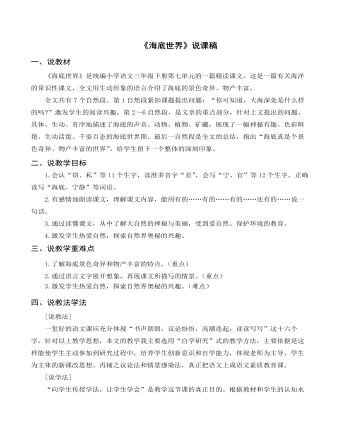
(说课稿)部编人教版三年级下册《 海底世界》
三、说教学重难点1.了解海底景色奇异和物产丰富的特点。(重点)2.通过语言文字展开想象,再现课文所描写的情景。(重点)3.激发学生热爱自然,探索自然界奥秘的兴趣。(难点)四、说教法学法[说教法]一堂好的语文课应充分体现“书声朗朗,议论纷纷,高潮迭起,读读写写”这十六个字。针对以上教学思想,本文的教学我主要选用“自学研究”式的教学方法,主要依据是这样能使学生主动参加到研究过程中,培养学生创新意识和自学能力,体现老师为主导,学生为主体的新课改思想。再辅之议论法和情景感染法,真正把语文上成语文素质教育课。[说学法]“向学生传授学法,让学生学会”是教学这节课的真正目的。根据教材和学生的认知水平,主要向学生渗透自学的方法,让学生会读书,重视朗读,组织学生多种形式的读。在多读的基础上,通过学生想、划、议等活动,调动学生积极思维。
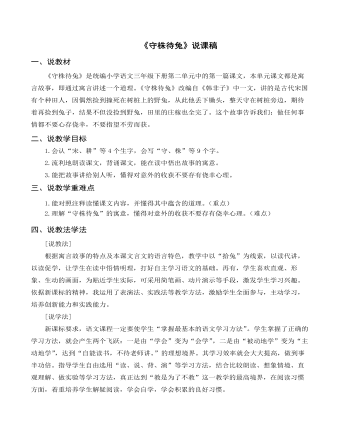
(说课稿)部编人教版三年级下册《 守株待兔》
五、说教学过程(一)谈话导入:1.孩子们,你们喜欢寓言故事吗?今天,老师将要和小朋友一起学习一则寓言故事。 2.板书课题:5守株待兔,齐读课题(强调"株"的读音)3.质疑:读了课题,你想知道什么呢? 梳理问题:“株”是什么意思?“守株待兔”是什么意思?过渡:刚才小朋友都交流了自己想知道的问题,那么我们要解决这些问题有一个最好的办法就是--(生)读书。(二)范读课文,整体感知(课件演示课文录像)伴随着老师的朗读请大家来欣赏课文,边听边思考刚才大家提出的问题,“株”在文中指的什么?(“株”指的是树桩。)树桩是露出地面的大树的一部分。我们再来看课题,“守株待兔”就是?(守着树桩等待兔子。)(三)初读课文,说出大意师:那么,这个人为什么要守着树桩等兔子呢?结果又怎么样呢?请同学们各自把课文读一读。遇到不认识的字该怎么办?(生读课文)
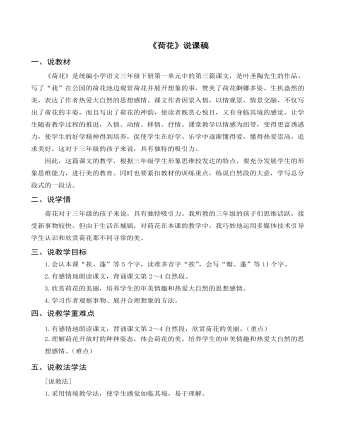
(说课稿)部编人教版三年级下册《荷花》
四、说教学重难点1.有感情地朗读课文,背诵课文第2~4自然段,欣赏荷花的美丽。(重点)2.理解荷花开放时的种种姿态,体会荷花的美。培养学生的审美情趣和热爱大自然的思想感情。(难点)五、说教法学法[说教法]1.采用情境教学法,使学生感觉如临其境,易于理解。2.直观教学法:通过多媒体的直观演示,激发学生学习课文的兴趣,突破教学难点。 3.以读代讲法。教学时让学生通过各种形式的读,读中理解,读中体会。[说学法]1.遵循以学生为主体,教师为主导,训练为主线的“三为主”原则,学生采用:看、听、读、品的方法学习。 2.采用探究性学习方法,使学生在阅读后自主探究合作。